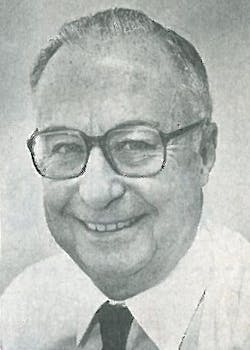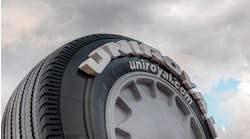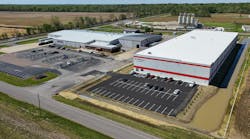Nowhere is the changing nature of the tire industry more evident than in Akron, Ohio, once “the Rubber Capital of the World.”
The recent decision of Michelin Americas Small Tires (MAST) to virtually close its operations there by August of next year is only the latest — but not the last — chapter in an exodus that began after World War II.
Except for a handful of research and development people, MAST is moving everyone to its parent company’s headquarters city, Greenville, S.C.
It has been years now since rubber moguls representing a huge portion of the tire industry spent their evenings chatting over cocktails at Portage Country Club.
The good old days — when living was easy — are gone forever.
Some say they are victims of global competition.
Possibly.
But others blame complacency.
Akron doesn’t even smell the same any more.
Gone are the aromas of the rubber plants and of Quaker Oats, whose grain elevators have now been turned into a round hotel.
Gone with them are who-knows-how-many-rubber-related jobs. Most guesses are between 80,000 and 90,000.
Most of these jobs left years ago. The recent pull-outs are only the final acknowledgment of what has already happened.
Around the city stand the old brick multi-storied factories, shells of their former selves — full of memories, but not much else.
Some say tire manufacturing left for more modern and efficient factories in the South and West.
Possibly.
But they also escaped the Akron rubber shop tradition of a six-hour work day reduced still further by work rules that cut production time in the plants even more.
Even after the tire plants left, company headquarters remained.
Until a few years ago, that is.
All of Akron’s tire companies except Goodyear were acquired by foreign competitors with no ties to Akron nor memories of earlier times.
They had purchased companies fallen on hard times. Some say they were uncomfortable in Goodyear’s shadow. Many believe they simply wanted a fresh start elsewhere.
The latest defection by MAST involves a company that saw no reason to remain in a town an inconvenient plane ride away from its South Carolina headquarters.
In announcing that by August of 1995 it would be gone completely it was only making official a process that began when Michelin acquired Uniroyal Goodrich four years ago.
Uniroyal Goodrich could trace its Akron ancestry to Benjamin Franklin Goodrich the man who began building bicycle tires on the banks of the Ohio Canal 147 years ago.
B.F. Goodrich had the first rubber research lab in America and built tires for the first cars ever made for sale in this country.
These were the glory days when Goodrich was known as the industry’s innovator, producer of the first passenger tires made with synthetic rubber, for example.
But Goodrich shifted emphasis to chemical and aerospace operations, was reorganized and finally became the Uniroyal Goodrich Tire Co., a joint venture destined to fail.
By the time Michelin purchased the company in 1990 Goodrich was no longer involved in the company, having sold its 50% share to a New York investment firm.
And when MAST completes its move from town next year only 235 jobs will be leaving, all that are left of the 900 that existed when the firm was sold.
Firestone, too, is gone.
The company was born in Akron in 1900.
And old-time Akronites remember when it once closely challenged Goodyear for the title of America’s largest tire- maker.
But Bridgestone executives were never comfortable in Akron after the Japanese company took over Firestone.
They moved all but a handful of Bridgestone/Firestone Inc. (BFS) people to a new headquarters in Nashville in 1990.
In Akron some say old-time Firestone workers and executives spurred the move with their reluctance to accept the change in ownership.
By the time of the final departure there remained only about 300 jobs of some 1,350 that existed when Bridgestone took over.
Mohawk Rubber was another Akron old-timer dating back to its founding there in 1913.
Now it’s part of parent company Yokohama’s headquarters in California with only a token handful of administrative people working in Akron.
And the exodus is not yet over.
General Tire, an Akron fixture since 1915, has notified its employees it is “studying” the possibility of moving its Passenger and Light Truck Division to Charlotte, N.C., where the Continental Tire subsidiary has a tire plant.
The departure from Akron of some other functions is already taking place.
The Passenger and Light Truck Division is an operation that represents about three-fourths of General’s sales.
The profitable Commercial Division is presently scheduled to remain in Akron as is corporate headquarters.
But commercial production is focused in Mt. Vernon, Ill., site of General’s joint venture state-of-the-art truck and bus tire plant. Who knows what the future will hold?
Like Goodrich, General’s core company, GenCorp lost interest in making tires years ago after diversifying into chemicals, aerospace, entertainment and other areas.
The company has been struggling both before and since it was acquired by Germany’s Continental Tire.
Many Akronites believe that eventually Goodyear could become the only significant tire game in town.
The familiar complex on E. Market St. has long represented the heart and soul of the city.
The community rose in arms and helped to drive off Sir James Goldsmith when he threatened to take over the company.
Most residents find it inconceivable that Goodyear would ever leave.
As long as Goodyear’s newest blimp — “The Spirit of Akron” — drifts lazily overhead, residents are reminded that while things could be better, all is well with the world.
So a new breed of Akronites — most not rubber executives — will sip drinks tonight at the Portage Country Club.
And only a few security light bulbs will glow at the old tire plants.
Reality has set in. There’s a new Akron growth industry in tires.
Memories.


